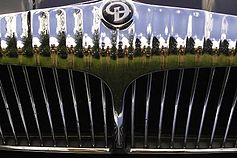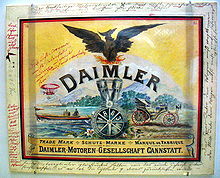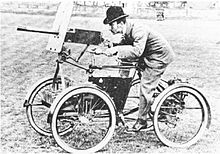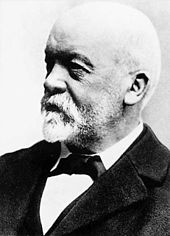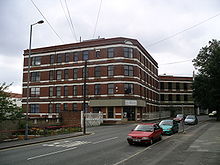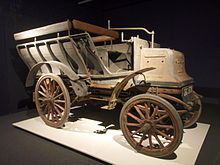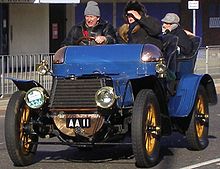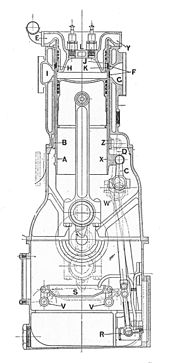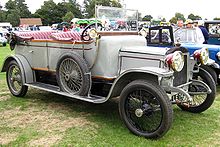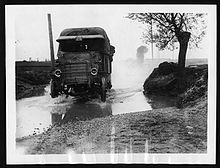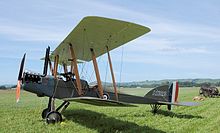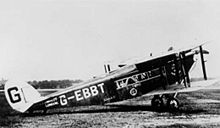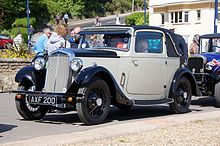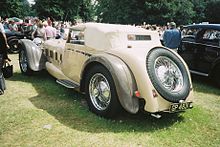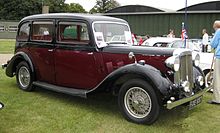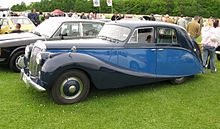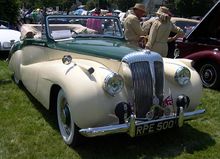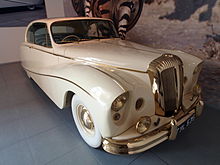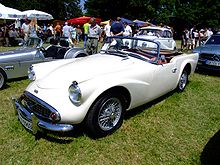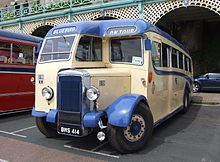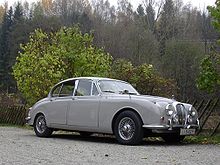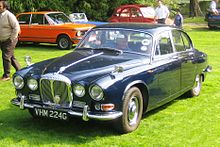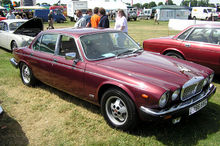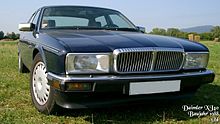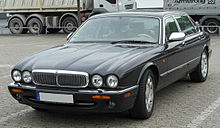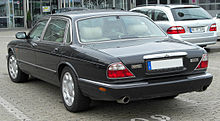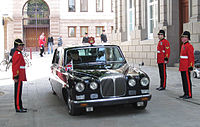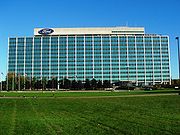- Daimler Motor Company
-
- This article is about the Daimler brand and its owner the British automobile manufacturer Daimler Motor Company. See Daimler for other uses derived from the German engineer and inventor Gottlieb Daimler. For the two direct descendants of Daimler's original enterprise, see Daimler-Benz (and its successor Daimler AG) and Austro-Daimler.
The Daimler Motor Company Limited 
Industry Automotive Fate from 1960 a division of
Jaguar Cars Limited
Browns Lane Allesley
Coventry CV5 9DRSuccessor Jaguar Cars continue to use the Daimler name Founded 1896 Headquarters Coventry, West Midlands, United Kingdom Key people Percy Martin
Edward ManvilleProducts Motor vehicles Employees 16,000 Parent from 1910 to 1960 The Birmingham Small Arms Company Subsidiaries Lanchester Motor Company
Daimler Hire
Daimler Air Hire
Daimler Airway
Transport Vehicles (Daimler)
Hooper & Co
Barker & Co
Carbodies
Hobbs Transmission
Stratton-InstoneDaimler brand name 
Type Motor vehicles Owner Tata Group through Jaguar Land Rover Country Gottlieb Daimler, Germany Introduced 1891 Related brands Jaguar Cars Markets International Previous owners The Daimler Motor Company (1896–1910)
BSA Group (1910-1960)
Jaguar Cars (1960–1966)
British Motor Corporation (1966–1966)
British Motor Holdings (1966–1968)
British Leyland (1968-1984)
Jaguar Cars (1984–1989)
Ford PAG (1989-2007)Registered as a trademark in not known Website www.daimlercars.com The Daimler Motor Company Limited was an independent British motor vehicle manufacturer founded in London by H J Lawson in 1896, which set up its manufacturing base in Coventry. The right to the use of the name Daimler had been purchased simultaneously from Gottlieb Daimler and Daimler Motoren Gesellschaft of Cannstatt, Germany. As of 2011, the brand appears to be dormant.
Current status
The Daimler Motor Company Limited is still registered as active and accounts are filed each year though it is currently marked "non-trading".[1]
All the Daimler shares were purchased from BSA by Jaguar Cars in 1960. After the introduction of the Daimler DR450 new models used Jaguar bodies with Daimler grilles and badging.[note 1] Daimler remains in the ownership of Jaguar Cars which now belongs to Tata Group of India.
Before 5 October 2007 Jaguar, while still controlled by Ford, reached agreement to permit then de-merging DaimlerChrysler to extend its use of the name Daimler. The announcement of this agreement was delayed until the end of July 2008 and made by Jaguar's new owner, Tata.[note 2] This agreement might have substantially reduced the price paid by Tata.
As of 2008, Jaguar's use of the Daimler brand was limited to one model, the Daimler Super Eight.
People
Some of the men who led “The Daimler” and some whose work gave special assistance.[2]
- Gottlieb Daimler inventor of the high-speed petrol engine who lent his name to his friend and English agent, Simms
- Frederick Richard Simms (1863-1944) 1890-1896 consulting mechanical engineer, Gottlieb Daimler’s agent who proposed this car business
- Henry John Lawson (1852-1925) 1896-1904 company promoter, floated Daimler on the London Stock Exchange and started the business
- James Sidney Critchley (1865-1944) 1896-1901 first works manager and a director
- Henry Sturmey (1857-1930) 1896-1899 journalist, Autocar and Motor, chairman of Daimler
- Edward George Jenkinson (1837-1919) 1898-1906 chairman of Daimler
- Percy Martin (1871-1958) 1901-1934 electrical engineer, American-born managing director of Daimler and BSA director
- Edward Manville (1862-1933) MP 1905-1933 consulting electrical engineer, chairman of Daimler and BSA
- Charles Yale Knight (1868-1940) 1907-1908 sleeve-valve engine
- Ernest Martyn Critchley Instone (1872-1932) 1896-1932 sales Stratton-Instone Stratstone
- Undecimus Stratton (1868-1929) 1903-1929 courtier. sales Stratton-Instone Stratstone
- Frederick Lanchester (1868-1946) "1907-1930" consulting engineer, polymath
- Dudley Docker (1862-1944) 1910-1944 industrialist and financier
- Laurence Henry Pomeroy (1883-1941) 1926-1936 managing director
- Walter Gordon Wilson (1874–1957) preselector gearbox
- Dr. Hermann Föttinger (1877-1945) fluid flywheel
- Edward Henry William Cooke (1875-1951) 1937-1941 managing director of Daimler, director of BSA
- George Hally ( -1975) 1941-1948 managing director of Daimler
- James Leek ( - ) 1913-1957 managing director of Daimler and Cycles and Guns, director of BSA
- Bernard Docker (1896-1978) 1939-1956 BSA chairman
- Norah Royce Docker née Turner (1906-1983) 1949-1956 publicist
- John Young Sangster (1896-1977) 1951-1961 BSA chairman
- Edward Turner (1901-1973) 1957- Daimler V8 engine designer
- Eric Turner (1918-1980) 1 January 1960-1971 BSA chairman
Foundation of the Coventry business 1896
The name Daimler is used by two completely separate groups of car manufacturers. The history of both enterprises can be traced back to the German engineer Gottlieb Daimler who built the first four-wheeled car in 1889.
Cannstatt
This German firm, initially operating at Cannstatt near Stuttgart, was the origin of the business variously known as Daimler Motoren Gesellschaft from 1890 to 1926, Daimler-Benz from 1926 to 1998, DaimlerChrysler from 1998 to 2007 and now Daimler AG or Daimler Germany, which has also manufactured vehicles since the 1890s but no cars with the name Daimler since 1908.
Coventry
The British business was begun by engineer F R Simms who was Hamburg born-and-raised though of English parents. Simms was impressed by Daimler’s motor when supervising construction of an aerial cableway of Simms own design for the Bremen Exhibition in 1889. Daimler, an ardent Anglophile, had spent from autumn 1860 to summer 1862 working in England then regarded as “the motherland of technology”.[3] Simms’ then wife was Austrian. The two men became firm friends though Simms was near thirty years younger.[2]
Simms first introduced Daimler’s motors to England in 1890 to power launches. At the beginning of 1891 (agreement dated 18 February 1891) he obtained British (and British Empire) rights for the Daimler patents and he founded Simms & Co consulting engineers in June 1891. His Daimler related work was later moved into his new company named The Daimler Motor Syndicate Limited formed 26 May 1893.[2]
On 7 June 1895 Simms told his own board he wished to form a company to be known as The Daimler Motor Company Limited (DMC) to acquire both the right to use the name Daimler and the British rights to the Daimler patents. It would manufacture Daimler motors and cars in England. In July 1895 he arranged an agency for the Daimler-powered Panhard & Levassor cars in Britain. Simms asked his good friend Daimler to be consulting engineer to the new enterprise.[2]
Simms revives Cannstatt
Simms was approached on 15 October 1895 by H J Lawson of The British Motor Syndicate Limited. Lawson wanted to arrange the public flotation of the proposed new company (and acquire a large shareholding for his British Motor Syndicate). Welcomed by Simms the negotiations proceeded on the basis that this new company should acquire The Daimler Motor Syndicate Limited as a going concern including the name and patent rights.[2]
Healing Cannstatt's splintering
Gottlieb Daimler and Maybach had withdrawn from Daimler Motoren Gesellschaft to concentrate on cars. Now, towards the end of 1895, without Daimler and Maybach, DMG was drifting towards bankruptcy. Agreement was needed from all the former partners to the transfer of the licences to the new English business. Simms offered to pay DMG £17,100 for that transfer on the condition that Daimler and Maybach rejoined DMG. This was agreed in November 1895 and the Daimler-Maybach car business re-merged with DMG’s. Daimler was appointed DMG’s General Inspector and Maybach chief Technical Director. At the same time Simms became a director of DMG but did not become a director of the London company. Those close to Daimler considered it ‘no mean feat’ that Simms had managed to obtain Daimler’s signature to the proposed re-amalgamation.[2]
On 14 January 1896 Lawson incorporated The Daimler Motor Company Limited. A prospectus was issued on 15 February. The subscription lists opened on 17 February and closed, oversubscribed, the next day. The Daimler Motor Company Limited bought The Daimler Motor Syndicate Limited as a going concern. One of Lawson’s associates had for sale an empty four-storey cotton mill in Coventry which was promptly purchased and that is how the British motor industry came to begin in Coventry.[2]
In mid 1900 Frederick Simms, as a director of the German firm, proposed a Daimler union between Coventry and Cannstatt but nothing came of the proposal.[2]
Name confusion
Aristocrat and car dealer Emil Jellinek had legal problems selling German Daimlers in France, Panhard-Levassor also used the name as they used German Daimler engines. Jellinek proposed to Daimler Germany that he would place a large order if they would make a car for him that bore his daughter's name, Mercedes. Daimler Germany now recognized they shared their right to the name Daimler with many others and to avoid further legal action the name Mercedes was adopted in 1902 for all the cars built by Daimler Motoren Gesellschaft itself. The name Daimler was last used for a German-built car in 1908.
The Vienna Austro-Daimler business has survived as Steyr-Daimler-Puch, despite being absorbed by General Dynamics in 2003.
Daimler, history of the British business 1896-1960
Motors, launches, cars
In February 1891 Cannstatt loaned Simms a motorboat with a 2 hp engine and an extra engine and in June, named Cannstatt, it began running on the Thames from Putney. Simms had set up a London office at 49 Leadenhall Street and, later, works premises on the Thames at Eel Pie Island where Pears Soap had been making electric motors. The launch business rapidly gained momentum.[2]
At the June 1895 board meeting Simms detailed his plans to form The Daimler Motor Company Limited and to build a brand-new factory, incorporating light rail, for 400 workmen making Daimler Motor Carriages. He then proudly produced the first car licence, for a 3½hp Panhard & Levassor (later referred to as a ‘Daimler Motor Carriage’). Bought in France by Evelyn Ellis, who had three Daimler motor launches moored by his home at Datchet, it was landed at Southampton on 3 July and driven by Ellis to Micheldever near Winchester where he met Simms and they drove to Datchet. Ellis later drove it on to Malvern. This was the first long journey by motorcar in Britain. Simms firmed up his plans for the new business and new factory selecting a six-acre site at Cheltenham.[2][note 3]
Then, unexpectedly, Simms received Lawson’s proposal to purchase The Daimler Motor Syndicate as a going concern. It was promptly accepted. The purchase was completed on 27 March 1896 and Lawson took control. Simms was appointed consulting engineer to the new business but was not to be on the board of directors, possibly because he had become a director of the Cannstatt firm. The Coventry mills were purchased and named Motor Mills. A deal was concluded with Panhard & Levassor in which the Cannstatt firm would receive a commission of 10% on British sales.[2] 1896 passed with car sales limited to imported Panhard and Peugeot cars. Aside from engines Cannstatt seemed unable to supply ordered components or specially commissioned working drawings. Four experimental cars were built and some (redesigned in detail) Daimler engines.[2]
The first Coventry Daimler-engined product made its maiden run on 2 March 1897.[2] By mid-year they were producing three of their own cars a week and producing Léon Bollée cars under licence. The first car left the works in January 1897, fitted with a Panhard engine, followed in March by Daimler engined cars. Lawson claimed to have made 20 cars by July 1897 making the Daimler Britain's first motor car to go into serial production, an honour that is also credited to Humber motors who had also displayed, but in their case their production models, at the Stanley Cycle Show in London in 1896. The Daimlers had a twin-cylinder, 1526 cc engine, mounted at the front of the car, four-speed gearbox and chain drive to the rear wheels.
Royal patronage
Known as Britain's oldest car manufacturers, Daimler became the official transportation of royalty in 1898, after the Prince of Wales, later Edward VII, was given a ride on a Daimler by John Douglas-Scott-Montagu later known as Lord Montagu of Beaulieu. Scott-Montagu, as a Member of Parliament, also drove a Daimler into the yard of the British Parliament, the first motorized vehicle to be driven there. Daimler received another Royal Warrant early in 1908, “Motor Car Manufacturer to the Court of Prussia” and the same year yet another as “suppliers of motor cars to the Court of Spain”.
“Few car salesmen ever owned a house on the fashionable Old Mile at Ascot, maintained a stable of racehorses and trotters and rode to Royal Ascot as a guest in the King’s landau.”[5]
Undecimus Stratton (1868-1929) known to friends as Eugene (Undecimus meaning eleventh child, as indeed he was), was born into a family acceptable at the royal court. A notable athlete and rugby player and record-setting balloonist friend of C S Rolls. Stratton became a lawyer then started his own brewery, and, by the time he was in his early thirties, was able to marry a noted society beauty and to retire in great comfort. As a now wealthy motoring enthusiast he stopped one day in 1903 and offered help with a large Daimler stranded by the roadside. The Daimler’s owner was impressed by Stratton and by his motoring knowledge. He was E. G. Jenkinson, the chairman of Daimler and then hunting a replacement head for Daimler’s London depot, a particularly sensitive position because of the royal cars. Taking up the position Stratton soon found himself deep in the selection of better royal chauffeurs and mechanics. He quickly became an occasional motoring companion to the King and before long motoring counsellor to other monarchs including the Emperor of Germany and the King of Spain. In 1911 he spent some weekends at Sandringham tutoring the new Prince of Wales on the workings of an automobile and then its driving. In 1921 Stratton went into partnership with Ernest Instone and they took charge of the Daimler showrooms at 39 Pall Mall naming the business Stratton-Instone. Each morning at eleven a butler in morning suit brought oysters and champagne to the directors’ rooms. Stratton died suddenly in 1929. His successors and Instone bought out Daimler in 1930 and renamed the business Stratstone Limited. The following summer the future King Edward VIII rented Stratton’s house at Sunningdale from his widow.[5]Every British monarch from Edward VII to the current queen has been driven in Daimler limousines. In 1950, after a transmission failure on the King's car, Rolls-Royce was commissioned as the Royal Primary Carriage, Daimler being reduced to "second fiddle". The current official state car is either one of a pair specially made for the purpose by Bentley, unofficial chauffeured transport is by Daimler.
Fluted radiator
Since 1904, the fluted top surface to the radiator grille has been Daimler's distinguishing feature. This motif developed from the heavily finned water-cooling tubes slung externally at the front of early cars and clearly visible in the photograph of the 1903 car to the right.
Sleeve-valve engines
Attracted by the possibilities of the "Silent Knight" engine Daimler's chairman contacted Knight in Chicago and Knight settled in England near Coventry in 1907. Daimler contracted Dr Frederick Lanchester as their consultant for the purpose and a major re-design and refinement of Knight's design took place in great secrecy. Knight's design was made a practical proposition.[2] When unveiled in September 1908 the new engine caused a sensation. "Suffice it to say that mushroom valves, springs and cams, and many small parts, are swept away bodily, that we have an almost perfectly spherical explosion chamber, and a cast-iron sleeve or tube as that portion of the combustion chamber in which the piston travels."[6]
The Royal Automobile Club held a special meeting to discuss the new engine, still silent but no longer "Wholly Knight". The Autocar reported on "its extraordinary combination of silence, flexibility and power." In recognition of the design's success the RAC awarded Daimler their coveted Dewar Trophy. Daimler bought rights from Knight "for England and the colonies" and shared ownership of the European rights, in which it took 60%, with Minerva of Belgium. Daimler dropped poppet-valve engines altogether. Sales outran the works' ability to supply.
Daimler's sleeve valve engines idle silently but when they left royal engagements Daimlers often departed in a just-visible haze of oil smoke. These engines had quite high oil consumption, oil being needed to lubricate the sleeves particularly when cold, but by the standards of their day they required almost no maintenance.[2]
Daimler kept their silent sleeve-valve engines until the mid 1930s. The change to poppet valves beginning with the Fifteen of 1933.[2]
BSA amalgamation 1910
This business deal was engineered by F Dudley Docker, deputy-chairman of BSA and famous for previous successful business mergers. He later created the Metropolitan-Vickers combine. His son Sir Bernard Docker (1896–1978) became a key player in Daimler's history.[2]
Under an agreement dated 22 September 1910[7] the shareholders of The Daimler Motor Company Limited "merged their holdings with those of the Birmingham Small Arms Company (BSA) group of companies". They handed in their Daimler shares for new BSA shares. BSA produced bicycles and motorcycles and rifles, ammunition and military vehicles as well as some BSA branded cars.
Immediately before the merger Daimler had a payroll of 4,116 workmen and 418 staff. The chairman of the enlarged group was Edward Manville who had been chairman of the Society of Motor Manufacturers and Traders - founded by Simms - since 1907.
Transport of emperors, kings and princes
By 1914 Daimlers were in the service of royal families including Great Britain, Russia, Germany, Japan, Spain, Sweden, Greece; its list of owners among the British nobility "read like a digest of Debrett"; the Bombay agent supplied Indian princes; the Japanese agent, Okura, handled sales in Manchuria and Korea.
World War I work
War was declared on 4 August 1914. It would last until 11 November 1918 and involve much of the world in the conflict.
The military took normal production of cars, lorries, buses and ambulances together with a scout army vehicle and engines used in ambulances, trucks, and double-decker buses. Special products included aero engines and complete aircraft, tank and tractor engines and munitions.
Aero engines manufactured by Daimler included: the French designed Gnome Monosoupape rotary engine, the air-cooled V8 RAF 1. Followed by RAF1a, the V12 RAF4 and RAF4a, Le Rhone and Bentley BR2.
Daimler trained air force mechanics in its works and its training methods became the standard for all manufacturers instructing RAF mechanics.[2]Having its own bodyshop Daimler moved to building the complete flying machine and by the end of 1914 they had built 100 of the BE2c. These were followed by the BE12 and RE8. Their own test-ground beside the factory was compulsorily purchased and became the main RAF testing ground for aircraft built in the Coventry district. After tooling up for the FE4 raider bomber that project was cancelled. The last wartime aircraft produced was the DH10 bomber when they were building 80 aeroplanes a month.[2]


Daimler-Foster 105 hp[4] tractor
towing artillery on a Fosters built trailer, Flanders 1917. Photo by Ernest Brooks.The first special production in late 1914 were the power trains used in the Fosters of Lincoln made massive artillery tractors to haul 15-inch (380 mm) howitzers. As a result Daimler produced engines for the very first tanks ever built in 1914 ("Little Willie" and "Big Willie" or "Mother"). One major difficulty for the tanks was the fine oil haze above their Daimler engines which the enemy quickly learned meant tanks were operating nearby if out of sight! The early tanks weighed up to 28 tons. They were all Daimler powered. Modifications designed by W. O. Bentley upgraded output from 105 to 125 horsepower during production. Derivatives included a gun-carrier and a supply vehicle and a salvage machine to rescue broken-down tanks and heavy guns.[2]
Daimler made more twelve inch (305 mm) shells than any other business in the country, 2000 a week. Each was machined from a 994 lb forging down to a finished weight of 684 lb.[2]
Civil aviation
After the Armistice it was decided that Daimler Hire should extend its luxury travel services to include charter aircraft through a new enterprise, Daimler Air Hire. Following the take-over of Airco and its subsidiaries in February 1920 services included scheduled services London-Paris as well as "Taxi Planes" to "anywhere in Europe". In 1922 under the name of Daimler Airway services extended to scheduled flights London to Berlin and places between. Frank Searle, managing director of Daimler Hire and its subsidiaries moved with his deputy Humphery Wood into the new national carrier Imperial Airways at its formation on 1 April 1924. Searle and Wood and their Daimler Airway machines formed the core of Imperial Airways operations.
Commercial vehicles
In late 1920s, it, together with Associated Equipment Company (AEC), formed the Associated Daimler Company to build commercial vehicles.
Lanchester acquisition and Badging
In 1930 the bulk of Daimler's shareholding in its subsidiary Daimler Hire Limited was sold to the Thomas Tilling Group[8] and, in January 1931, Daimler completed the purchase of The Lanchester Motor Company.[8] The new Lanchester 15/18 model introduced in 1931 was fitted with Daimler's fluid flywheel transmission.[8]
Although at first they produced separate ranges of cars with the Daimler badge appearing mainly on the larger models, by the mid 1930s the two were increasingly sharing components leading to the 1936 Lanchester 18/Daimler Light 20 differing in little except trim and grille.[9]
This marketing concept already employed with their BSA range of cars continued to the end of Lanchester and BSA car production. Some very important customers were supplied with big Daimler limousines with Lanchester grilles.[2] The Daimler range was exceptionally complex in the 1930s with cars using a variety of six and eight cylinder engines with capacities from 1805 cc in the short lived 15 of 1934 to the 4624 cc 4.5 litre of 1936.
Mid-term review and outlook
Daimler Drophead coupé 1933
on a Daimler Fifteen[4] 2 litre Six chassis
first poppet-valve Daimler since 1909
in fact a de luxe version of the new four cylinder 1200cc Lanchester Ten and Depression fareBy 1930 the BSA Group's primary activities were BSA motorcycles and Daimler vehicles.[10]
Through the whole life of its business Daimler seemed to suffer from often truly crippling boardroom battles, intense personal rivalries.
It has been suggested Simms and Daimler soon withdrew from their initial association with Lawson because Lawson showed little potential ability for managing a manufacturing business. Altogether an unsatisfactory group of people to be associated with. Once relieved of Lawson the next period, Sturmey's chairmanship, suffered from the division between his supporters and his opponents. Sturmey departed in 1899.
Yet in the early 1900s the achievement of a Royal Warrant and acquisition of some capable talent led to improved fortunes; Percy Martin, a substantial shareholder, as works manager and Ernest Instone as general manager under the chairmanship of Sir Edward Jenkinson. Jenkinson was succeeded in 1906 by Edward Manville a distinguished consulting engineer who was to become chairman of BSA. The involvement of the Docker family, father and son, from 1910 failed to solve boardroom difficulties transferred to BSA and in the end may have brought about disaster but in any case the collective Daimler leadership did well until the late 1920s and the business prospered. Its repute and its profits grew. "Side by side with an apprenticeship scheme which was as good as any in the trade, they had begun to attract pupils from public schools with such success that shortly before (Word War I) there was a hostel full of them in a pleasant house in St Nicholas Street near the Coventry works."[11] During that war the labour force grew from 4,000 to 6,000 men.
Manville died in 1933, Percy Martin was forced out two years later, Frederick Lanchester resigned as consultant in 1936, Laurence Pomeroy was not re-elected to the board and left for de Havilland. Ernest Instone had left the works in the early 1920s to concentrate his efforts on distribution (Stratton-Instone) but he too died, in 1932.
The staid Daimler was never a young man's car. It might be smooth silent and impeccable but a Bentley or Hispano-Suiza was a great deal faster and more appealing to the adventurous. Most important of all Daimler was not paying dividends and by 1936 BSA shareholders' meetings were stormy. Attempted solutions had been the 10hp Lanchester and its matching but 6-cylinder stable mate the Daimler Fifteen (later DB17 and DB18) introduced in the early thirties. This line as the Lanchester Fourteen and Daimler Conquest was to run through to the very end.
Edward H W Cooke attempted a revival and from 1937 introduced saloons with a freshness of design new to Daimler. The new products had remarkable successes in competitions and rallies. His policy was proved sound but another war, post-war austerity and yet more boardroom battles, this time in public, seemed to put an end to Daimler's once-proud business.[11]
Daimler's semi-automatic transmissions
Low-chassis Daimler double-six 50hp[4]
4-seater drophead coupé (1931)
by Corsica of Cricklewood
chassis modified by Reid Railton at Thomson & Taylor LtdDaimler became a proponent of the preselector gearbox and Fottinger's fluid flywheel. They were introduced by Daimler in 1930 on their double-six 30 for an extra £50[12][13] and soon they were used in all Daimler vehicles. The chairman reported to the shareholders at their Annual General Meeting in November 1933 "The Daimler Fluid Flywheel Transmission now has three years of success behind it and more than 11,000 vehicles, ranging from 10 h.p. passenger cars to double-deck omnibuses, aggregating over 160,000 h.p., incorporate this transmission. . . . . it has yet to be proved that any other system offers all the advantages of the Daimler Fluid Flywheel Transmission. Our Daimler, Lanchester and BSA cars remain what we set out to make them—the aristocrats of their class and type. . . . We have also received numerous inquiries from overseas markets. (Applause)".[14] These transmissions remained in production until replaced by Borg-Warner fully automatic units beginning in the mid 1950s. Late in that period a new Lanchester model with a Hobbs fully automatic gearbox did not, in the end, enter full production.
Royal Daimlers
A wide variety of engines were made in the earlier years. In an attempt to give some kind of indication of the complexities involved what follows is a list, by year of first supply, of the different engines in cars supplied to the King. In many cases a number of cars were supplied with the same engine and over a period of some years.
- 1899 6 hp 2 cylinder 1.527 litres
- 1901 12 hp 4 cylinder 2.324 litres TA
- 1903 22 hp 4 cylinder 5.733 litres TB
- 1904 22 hp 4 cylinder 5.702 litres TB
- 1904 28 hp 4 cylinder 6.786 litres TB
- 1905 30 hp 4 cylinder 7.246 litres TJ
- 1905 35 hp 4 cylinder 8.462 litres TK
- 1905 35 hp 4 cylinder 9.236 litres TK
- 1907 30 hp 4 cylinder 4.942 litres TO
- 1908 42 hp 4 cylinder 7.964 litres TC
- 1908 58 hp 4 cylinder 10.431 litres TC
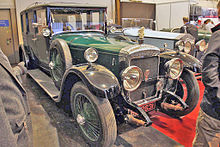 Daimler 57hp[4] 6-cyl 9½ litres
Daimler 57hp[4] 6-cyl 9½ litres
limousine by Hooper 1923 example
private purchaser but as supplied to King George V- 1909 38 hp 4 cylinder 6.281 litres TC
- 1909 57 hp 6 cylinder 9.420 litres TC
- 1911 23 hp 6 cylinder 3.921 litres TA
- 1911 38 hp 6 cylinder 9.420 litres TH
- 1914 20 hp 4 cylinder 3.308 litres TO
- 1914 45 hp 6 cylinder 7.412 litres TB
- 1920 30 hp 6 cylinder 4.962 litres TL
- 1923 45 hp 6 cylinder 7.413 litres TJ
- 1924 20 hp 6 cylinder 2.648 litres C
- 1925 45 hp 6 cylinder 8.458 litres N "The largest production car in the world"
- 1926 35 hp 6 cylinder 5.764 litres R
- 1928 30 hp 12 cylinder 3.744 litres V Light Double Six
- 1929 25 hp 6 cylinder 3.568 litres V
- 1931 40/50 hp 12 cylinder 6.511 litres OP Double Six, fluid flywheel, self-changing gearbox
- 1935 25 hp 8 cylinder 3.746 litres Light Straight Eight
- 1935 50 hp 12 cylinder 6.511 litres Double Six
- 1936 32 hp 8 cylinder 4.624 litres Straight Eight
- 1937 24 hp 6 cylinder 3.317 litres EL24
The production programme for 1930 encompassed six engine types and seventeen variants on seven chassis types. A substantial part of the progamme had been completed and sold by November 1929. Orders held for 1930 were:
- 16 hp 1,180
- 20 hp 2,176
- 25 hp 1,735
- 35 hp 396
- 30 hp 236 Light Double Six
- 50 hp 74 Double Six
World War II work
War was declared on 3 September 1939. It would last until 15 August 1945 and again involve much of the world in the conflict.
During World War II, Daimler turned to military production. A four wheel drive scout car, known to the Arny as the Dingo, had a 2.5 litre engine, along with a larger armoured car powered by a 4.1 litre engine and armed with a 2pdr. were produced, both with six cylinder power units, fluid flywheels and epicyclic gearboxes.[15] These military vehicles incorporated various innovative features including all-round disc brakes.[15]
During the war Daimler built over 6,600 scout and some 2,700 Mk I and Mk II armoured cars. Tank components, particularly epicyclic gearboxes were provided for some 2,500 Crusader, Covenanter and Cavalier tanks. No complete aircraft as in the previous war but 50,800 radial aero-engines—Bristol Mercury, Hercules and Pegasus—with full sets of parts for a further 9,500 of these engines; propeller shafts for Rolls-Royce aero-engines; 14,356 gun-turrets for bombers including their Browning machine guns; 74,000 Bren guns—bombed-out that production had to be moved to a boot and shoe factory in Burton-on-Trent. Over 10 million aircraft parts were produced during the war.[2] All this production is Daimler's alone excluding BSA's other involvements.
Daimler's peak workforce, 16,000 people, was reached in this period.[2]
After that war, Daimler produced the Ferret armoured car, a military reconnaissance vehicle based on the innovative 4.1 litre engined armoured car they had developed and built during the war, which has been used by over 36 countries.
Brown's Lane
The original Sandy Lane plant, used as a government store, was destroyed by fire during intensive enemy bombing of Coventry, but there were by now 'shadow factories' elsewhere in the city including one located at Brown's Lane, Allesey—now itself destroyed—but which after the Jaguar takeover became for several decades the principal Jaguar car plant.[15] This acquisition, made by buying Daimler and getting a Coventry plant and its workforce, was a clever move by Sir William Lyons. Most motor industry members were forced by planning controls to expand in areas of unemployment without skilled operatives. Consequently they suffered lasting difficulties with quality of workmanship.
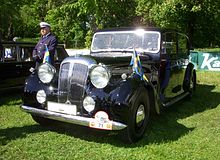 Daimler Twenty-Seven[4] limousine 1950
Daimler Twenty-Seven[4] limousine 1950
in May 2011 the oldest car in Sweden's Royal Mews in regular use Daimler Consort DB18 (1952 example)
Daimler Consort DB18 (1952 example)
postwar upgrade of 1938's venture into the middle-class market with the
Daimler New Fifteen[4] 2½ litre DB18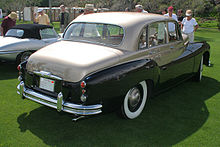 Daimler One-O-Four, 104mph (1955 example) a yet further development of the 1938 DB18,[4] bigger engines, big boot, better brakes and a fully automatic gearbox
Daimler One-O-Four, 104mph (1955 example) a yet further development of the 1938 DB18,[4] bigger engines, big boot, better brakes and a fully automatic gearbox
Postwar decline
Churchill, always a regular customer, did his electioneering for his first postwar election sitting on the top of the back seat of a discreetly fast and luxurious low-slung DB18 two door drophead coupé first registered in 1944. The government ordered new limousines for the top brass of the occupying forces. New straight-eights were supplied to the former colonies for the planned royal tours.[note 4]
Foreign monarchs[note 5] re-ordered to replenish their fleets. The 1946 golden jubilee of the founding of the business was celebrated with a luncheon at the Savoy.[2]
However 'austerity' seemed infectious. The new Lanchester looked just like a Ford Prefect and its body was made in the same factory. A new model Eighteen with a lot of aluminium because of the steel supply shortage, a modified pre-war Fifteen, was introduced with technical innovations limited to a new cylinder head and curved glass in its side windows now framed by elegant chromed metal channels. Windows were 'in'. The big DE27 and DE36 models were the first series-built cars with electrically operated windows.[2] Daimler ambulances became a common sight.
Then in June 1947 purchase tax was doubled—home market sales had already been restricted to cars for "essential purposes". Petrol remained rationed, ten gallons a month. Princess Elizabeth took her 2½ litre drophead coupé, an 18th birthday gift from her father, to Malta where her new husband was stationed. The King took delivery of a new open tourer straight-eight in March 1949. In the commodities boom caused by the 1950 Korean War Australasian woolgrowers reported the new electrically operated limousine-division to be 'just the thing' if over-heated sheepdogs licked the back of a driver's ears. The newest royal Daimler's transmission failed again and again.
This schedule shows where what should have been Daimler repeat-orders went to. Daimler subsidiary Hoopers at least got to make some of the bodies.Consorts discounted
Sir Bernard Docker took the extra responsibility of Daimler's Managing Director in January 1953 when James Leek was unable to continue through illness. Car buyers were still waiting for the new (Churchill) government's easing of the 'temporary' swingeing purchase tax promised in the lead up to the snap-election held during the 1951 Earl's Court motor show. Lady Docker told her husband to rethink his marketing policies. 3 litre Regency production was stopped. In the hope of keeping 4,000+ employed the Consort price was dropped from 4 February 1953 to the expected new tax-inclusive level.
Stagnation of all the British motor industry was relieved by the reduction of purchase tax in the April 1953 budget. Daimler announced the introduction of the moderately sized Conquest in May (apparently developed in just four months from the four-cylinder Lanchester 14 or Leda with a Daimler grille). But somehow it was all too late. The image had changed. Even local royalty deserted for Rolls-Royce.
Daimler and Lanchester, there were no more BSA cars, struggled after the War, producing too many models with short runs and limited production, and frequently selling too few of each model, while Jaguar seemed to know what the public wanted and expanded rapidly. Daimler produced heavy staid large and small luxury cars with a stuffy, if sometimes opulent image. Jaguar produced lower quality cars at a remarkably low price and they were designed for enthusiasts.
The BSA group's leadership of the world's motorcycle market was eventually lost to Japanese manufacturers.
Lady Docker's Daimlers
Sir Bernard Docker was the Managing Director of BSA from early in WWII, and married Norah Lady Collins in 1949. It was twice-widowed and wealthy in her own right Norah's third marriage, she had originally been a successful dance hall hostess. Lady Docker took an interest in her husband's companies and became a director of Hooper, the coachbuilders.
Daughter of an unsuccessful Birmingham car salesman[16] Lady Docker could see that the Daimler cars, no longer popular with the royal family, were in danger of becoming an anachronism in the modern world. She took it upon herself to raise Daimler's profile, but in an extravagant fashion, by encouraging Sir Bernard to produce show cars.
The first was the 1951 "Golden Daimler", an opulent touring limousine, in 1952, "Blue Clover, a two door sportsmans coupe, in 1953 the "Silver Flash" based on the 3 litre Regency chassis, and in 1954 "Stardust", redolent of the "Gold Car", but based on the DK400 chassis as was what proved to be her Paris 1955 grande finale, a 2-door coupé she named "Golden Zebra", the "last straw" for the Tax Office and now on permanent display at The Hague.
At the same time Lady Docker earned a reputation for having rather poor social graces when under the influence, and she and Sir Bernard were investigated for failing to correctly declare the amount of money taken out of the country on a visit to a Monte Carlo casino. Sir Bernard was instantly dumped "for absenteeism" by the Midland Bank board without waiting for the court case.[17][18] Norah drew further attention. She ran up large bills and presented them to Daimler as business expenses but some items were disallowed by the Tax Office. The publicity attached to this and other social episodes told on Sir Bernard's standing as some already thought the cars far too opulent and perhaps a little vulgar for austere post-war Britain.[19] To compound Sir Bernard's difficulty, the royal family shifted allegiance to Rolls Royce. By the end of 1960 all the State Daimlers had been sold and replaced by Rolls-Royces.
Some Daimler models
Some of the more well-known vehicles produced by Daimler and their factory catalogued variants by Barker and Hooper prior to Daimler's acquisition by Jaguar in 1960 were:
- 1896 First Daimler Vehicle
- 1908 switch to sleeve-valve engines
- 1926–1938 Daimler double-six
- 1933–1936 Daimler Fifteen 2.003 litres, first return to poppet-valve engines. popularly priced
- 1936–1953 Daimler Straight-Eight
- 1936-1940 Daimler Light Straight-Eight all-alloy 3421cc to 3960cc
- 1938–1939 Daimler New Fifteen 2.166 litres (DB17)
- 1938–1945 Daimler Scout (4wd 2½ litre) known to the Army as Dingo, made at J C Bamford Uttoxeter.
- 1939–1949 Daimler Eighteen 2½ litre (DB18). (prod: 3355)[20] New Fifteen with a Scout engine
- 1940– ? Daimler Armoured Car all-wheel-drive
- 1946–1952 Daimler Twenty-Seven DE27/DH27 (6 cyl.)[21] (prod: 255)[20]
- 1946–1953 Daimler Straight-Eight DE36[21] (prod: 205)[20]
- 1952–1971 Ferret Scout Car
- 1948–1953 Daimler DB18 2½ litre, Sports Special Barker drophead coupé, Hooper Empress - owner-driver and limousine (prod: 608)[20]
- 1949–1953 Daimler Consort 2½ litre (DB18), (prod: 4250)[20]
- 1952–1957 Daimler Regency 3 litre, Barker Special Sports Coupé, Hooper Empress - owner-driver and limousine (prod: 560)[20]
- 1953–1956 Daimler Conquest and Daimler Conquest Century 2½ litre, Barker Conquest Century coupé (prod: 9620)[20]
- 1955–1957 Daimler Conquest Century Roadster (prod: 119)[20]
- 1954–1960 Daimler Regina (DK400) 3½ or 4.6 litre, (prod: 132)[20] last Daimler car with preselector transmission, owner-driver and limousine
- 1955–1958 Daimler One-O-Four (prod: 561)[20] standard equipment included a vanity case with cosmetics by Max Factor
- 1958–1962 Daimler Majestic 3.8 litre, (prod: 1490)[20] One-O-Four with different shape, BW automatic transmission, 4 wheel disc brakes, owner-driver and limousine
Turner's engines
In 1951 Jack Sangster sold his motorcycle companies Ariel and Triumph to BSA, and joined their board. In 1956 Sangster was elected Chairman, defeating Sir Bernard 6 votes to 3. After a certain amount of electioneering by the Dockers an extraordinary shareholders' meeting backed the board decision and Bernard and Norah bought a brace of Rolls-Royces registering them as ND5 and BD9. Many important European customers turned out to have been Docker friends and did not re-order Daimler cars.[2]
Sangster promptly made Edward Turner head of the automotive division which as well as Daimler and Carbodies (London Taxicab manufacturers) included Ariel, Triumph, and BSA motorcycles. Turner designed the Daimler SP250 and Majestic Major, and their lightweight hemi head Daimler 2.5 & 4.5 Litre V8 Engines. Under Sangster Daimler's vehicles became a little less sober and more performance oriented. Their Majestic Major proved an agile high-speed cruiser on the new motorways.
- 1959–1964 Daimler SP250 V8 (Dart, A-spec.)
- 1959–1964 Daimler SP250 V8 (B and C spec.) (prod: 2645, A B & C)[20]
- 1959–1968 Daimler Majestic Major V8 (prod: 1180)[20]
- 1961–1967 Daimler DR450 Hemi V8 Limousine, (prod: 864)[20] a nimble high-speed top-executive transport and the last true Daimler
Hybrid - 1962–1969 Daimler 250 V8 a Daimler-engined Jaguar Mk 2 (prod: 17620)[20]
The two excellent Turner V8 engines disappeared with British Leyland's first rationalization, the larger in 1968 and the smaller a year later.
Daimler buses 1911-1973
A significant element of Daimler production was bus chassis, mostly for double deckers. Daimler had been interested in the commercial vehicle market from 1904. In 1906 it produced, using the Auto-Mixte patents of Belgian Henri Pieper, a petrol-electric vehicle and on 23 May 1906 registered Gearless Motor Omnibus Co. Limited.[22] It was too heavy. Following the introduction of Daimler-Knight sleeve-valve engines re-designed for Daimler by Dr Frederick Lanchester Lanchester also refined the Gearless design and it re-emerged in 1910 as the KPL (Knight-Pieper-Lanchester) omnibus, a very advanced integral petrol electric hybrid. The KPL bus had four-wheel brakes and steel unitary body/chassis construction.[2] Failure to produce the KPL set bus design back twenty years.
Introduction of the KPL was stopped by a patent infringement action brought by London General Omnibus's associate Tilling-Stevens in early May 1911 when just twelve KPL buses had been built. This was just after Daimler had poached LGOC's Frank Searle and announced him to be general manager of its new London bus service which would be using its new KPL type to compete directly with LGOC.[23]
Some of LGOC's vehicles used Daimler engines. With the collapse of Daimler's plans Searle, an engineer and designer of the LGOC X-type and AEC B-type bus, instead joined Daimler's commercial vehicle department. Reverting to (before LGOC) omnibus salesman Searle rapidly achieved some notable sales. 100 to Metropolitan Electric Tramways and 250 to LGOC's new owner, Underground.
First Searle designed for Daimler a 34-seater with gearbox transmission (the KPL used electric motors each side) very like the B-Type and it was introduced by Daimler in early 1912.[22] The main difference from what became the AEC B-Type was the use of Daimler's sleeve-valve engine. In June 1912 what had been LGOC's manufacturing plant was hived off as AEC. Between 1913–16 AEC built some Daimler models under contract and Daimler sold all AEC vehicles which were surplus to LGOC needs. After war service now Colonel Searle moved to Daimler Hire Limited and its involvement in aviation. The Searle models were developed after World War I, but from 1926–8 Daimler entered into a joint venture with AEC vehicles being badged as Associated Daimler.
In the 1930s the Daimler CO became the main model, there was a similar but heavier CW produced during World War II and in postwar years production worked through the Daimler CV to the long-running Daimler CR Fleetline, built from 1960 to 1980 (CVG5 and CVG6 had been a common type of bus in Hong Kong between 1950 to 1988 and Fleetline had also become a major type of bus in Hong Kong till 1995). Small numbers of single deck vehicles were also built. Many British bus operators bought substantial numbers of the vehicles and there were also a number built for export. The standard London double-decker bus bought from 1970 to 1978 was the Daimler Fleetline.
Daimler buses were fitted with proprietary diesel engines, the majority by the Gardner company, although there were a few hundred Daimler diesels built in the 1940s & 1950s, and the Leyland O.680 was offered as an option on the Fleetline (designated CRL6) after the merger with Leyland. The bus chassis were also fitted with bodywork built by various outside contractors, as standard in the British bus industry, so at a casual glance there is no real identifying feature of a Daimler bus apart from the badges (Daimler buses retained the distinctive fluted radiator grille top). The last Daimler Fleetline was built at the traditional Daimler factory in Radford, Coventry, in 1973, after that date the remaining buses were built at the Leyland factory in Farington, Lancashire, the final eight of years of Fleetline production being badged as Leyland. The last Fleetline built was bodied by Eastern Coach Works in 1981.
During that Jaguar-owned period 1960-1968, Daimler became the second-largest (after Leyland) double-decker bus manufacturer in Britain, with the "Fleetline" model. At the same time, Daimler made trucks and motorhomes. BMH merged with the Leyland Motor Corporation to give the British Leyland Motor Corporation in 1968. Production of Daimler buses in Coventry ceased in 1973 when production of its last bus product (the Daimler Fleetline) was transferred to Leyland plant in Farington. Daimler stayed within BLMC and its subsequent forms until 1982, at which point Jaguar (with Daimler) was demerged from BL as an independent manufacturer.
Jaguar, Daimler, William Lyons 1960
In May 1960, the Daimler business was purchased from BSA by Jaguar Cars[24] for 3.4 million pounds.[25] William Lyons was looking to expand manufacture, wanted the manufacturing facilities and had to decide what to do with the existing Daimler vehicles.
Jaguar had been refused planning permission for a new factory in the area in which it wanted it to be. Daimler had shrunk to representing just 15% of BSA group turnover in 1959-1960 and BSA wished to dispose of its motoring interests.[24] "Jaguars reiterate their previous statement that the production of the current range of Daimler models is to be continued. Furthermore, research and development work in connexion with future Daimler models will proceed normally. Jaguars deny rumors to the effect that sweeping changes, including even the extinction of the Daimler marque, are to be expected. The company's long term view envisages not merely the retention of the Daimler marque, but the expansion of its markets at home and overseas, it is stated."[25]
It is said that Jaguar put a Daimler 4.5L V8 in a Mark X, and it went better than the Jaguar version. It is also said that when Jaguar ceased production of Daimler designed vehicles, Lyons had all the spares bulldozed into a pit.[citation needed]
The Daimler Majestic Major and the sporty Dart, already in production, were continued for a number of years, using the Daimler V8 engine. In 1961 Daimler introduced the DR450, a limousine version of its Majestic Major with a longer chassis and bodyshell and higher roofline. It continued in production until the DS420 arrived in 1968, by which time it had sold almost as many as the "Major" saloon.
They were the last Daimler-badge cars not designed by Jaguar.
Daimler V8-250
The last car to have a Daimler engine was the V8-250 which was essentially, apart from a fluted top to its grille, different badges and drivetrain, a more luxurious Jaguar Mk 2. Its distinctive personality may have attracted buyers who would have avoided the matching Jaguar.
While this car became the most popular Daimler ever produced it had two remarkable characteristics:
- buyers did not include previous Daimler owners but rather people trading up from the bigger Ford, BMC or Rover cars.
- No-one traded their V8-250 for a new V8-250. This at a time when 60% of new Jaguars were sold in exchange for Jaguars.
Daimler Sovereign
The decision was straightforward, now there would be no more than a Daimler label for a luxury version of a Jaguar car. After discussion it was decided it would not be a Royale but a Sovereign.
Significant new Daimler models for this Jaguar-owned period include:- 1962–1969 Daimler 250 V8 (Daimler-engined Jaguar Mk 2)
- 1966–1969 Daimler Sovereign (badge-engineered Jaguar 420)
BMC—BMH, Jaguar, Daimler 1966
Jaguar was taken over by British Motor Corporation (BMC), the new masters of badge-engineering, in 1966 and a few months later BMC was re-named British Motor Holdings (BMH).[26][27][28]
Control and marketing
Sir William Lyons
Though Jaguar had diversified by adding, after Daimler, Guy trucks and Coventry-Climax to their group they remained dependent on Pressed Steel for bodies. Once BMC had taken control of Pressed Steel Lyons felt compelled to submit to the BMC takeover. Lyons remained anxious to see that Jaguar maintained its own identity and came to resent the association with British Leyland. He was delighted by Sir John Egan's accomplishments and by the new independence arranged in 1984.[29]
USA
At this point, 1967, it was decided there was insufficient in the group advertising budget to cope with marketing the Daimler brand in USA.[2]
Daimler DS420 Limousine
The Daimler DS420 Limousine introduced in 1968 and withdrawn from production in 1992 employed a strengthened Mk X Jaguar unitary carcass with a new roof and a rear extension—21 inches were let in to the floor pan behind the front seat by Rubery Owen. Finishing from the bare metal was carried out by Vanden Plas who had lost their Princess. The floor pan with mechanicals—a drive-away chassis— was also sold for specialized bodywork, mostly hearses. The very last hearse was delivered on 9 February 1994 to a Mr Slack, funeral director of Cheshire.[2]
Though entirely a Jaguar the DS420 was unique to Daimler. These stately limousines, wedding and funeral cars and the hearses made by independent coachbuilders, their majestic bulk preceded by the fluted grille, are now the way most remember Daimler cars.[note 6]
Daimler Sovereign, Daimler Double-Six
These were the first series of vehicles that were badge-engineered Jaguars (XJ Series), but given a more luxurious and upmarket finish. For example the Daimler Double-Six was a Jaguar XJ-12, the Daimler badge and fluted top to its grille and boot handle being the only outward differences from the Jaguar, with more luxurious interior fittings and extra standard equipment marking it out on the inside. Significant Daimler models for that period include:
- 1968–1992 Daimler DS420 Limousine, successor to the DR450, an extended Jaguar Mark X
- 1969–1983 Daimler Sovereign a badge-engineered Jaguar XJ6
- 1972–1992 Daimler Double-Six a badge-engineered Jaguar XJ12 series I II and III
(the 1986 XJ40 Jaguar body could not take a V12 engine)
Continental Europe
The Daimler name was dropped in Europe for two or three years in the early 1980s. Jaguar adopted the Sovereign designation. The Daimler name returned in Europe at the end of 1985. Jaguar decided it would have its part of the fortune European dealers were making from importing conversion kits of Daimler body parts to convert Jaguars to Daimlers.
Visitors to USA found fluted Daimlers labelled 'Jaguar Vanden Plas'.[2]
Chairmen
The Daimler brand was kept going by the local fleet market, a chairman could have his Daimler and board members their Jaguars.[2]
Jaguar's Daimler-trained chief executive
Lofty England, a Daimler apprentice 1927-1932, joined Jaguar in 1946.
Service manager, Jaguar Cars 1946-56, service director 1956-61, assistant managing director 1961-66, deputy managing director 1966-67, joint managing director 1967-68, deputy chairman 1968-72, chairman and chief executive 1972-74.[30]Jaguar's brief artificial independence 1984
If Jaguar was not to follow Daimler into becoming just another once iconic brand it needed immense amounts of capital to develop new models and build and equip new factories. This was beyond the ability of the BMH—now British Leyland—Group.[31] It was decided to market the Jaguar business by first obtaining a separate London Stock Exchange listing to fix a price then ensuring any successful bid for all the listed shares in the whole business would be from a bidder with, or with access to, the necessary capital.[32] That bidder proved to be Ford.
1984 produced a record group output of 36,856 cars but less than 5% were badged Daimler. Two years later Daimler's share had reached 11.5%—in fact almost 23% if the Vanden Plas for USA is included.
- 1986–1992 Daimler XJ40 new car and new engine as prescribed by British Leyland
Ford, Jaguar, Daimler 1989
In 1989 the Ford Motor Company paid £1.6 billion to buy Jaguar and with it the right to use the Daimler name. In 1992, Daimler (Ford) stopped production of the DS420 Limousine, the only model that was a little more than just a re-badged Jaguar.[note 6] In 1996 Jaguar Cars produced a "Daimler Century" model to celebrate 100 years of motoring.
The name Daimler continued to be used to determine top-line XJ Jaguars in every country except the USA, where the top XJ is known as the "XJ Vanden Plas" — Jaguar may have feared that the American market would confuse Jaguar Daimler with Daimler AG. Marketing of the Daimler name in USA had ceased in 1967.
Daimler Super V8
In 2002, with the arrival of the new Mark III XJ, the Daimler name (seen on the Mark II XJ as the "Daimler V8") was not immediately used to mark out the top models, with the "Jaguar Super V8" the new flagship model. However, the Daimler name was brought back with the "Super Eight" model.
Daimler Super Eight
In July 2005, after a three-year hiatus, a new Daimler, the Super Eight, was presented, with a 4.2 L V8 supercharged engine which produces 291 kW (396 PS; 390 bhp) and a torque rating of 533 N·m (393 lb·ft) at 3500 rpm. It is derived from the Jaguar XJ (X350).
Significant Daimler Models for the Ford Premier Auto Group period include:
- 1992-1994 Daimler Majestic XJ340 wheelbase extended 5 inches (130 mm); 3.2 and 4 litre engines
- 1992-1994 Daimler Majestic Double-Six XJ381 6 litre engine. Intended to take 75% of group V12 sales
- 1994-2002 Daimler X300 and X330 body returns to a more recognizable shape. V8 from 1997
- 1996 Daimler Century limited edition: 50 V12, 50 straight 6; marking 100 years of Daimler Coventry
- 2002-2005 Daimler Super V8 X350 V8 engine, alloy structure
- 2005 Daimler Super Eight
Daimler Corsica concept
A single 2-door convertible was built in 1996 to commemorate Daimler's centenary. The concept car, called the Daimler Corsica, was based on the Daimler Double-Six saloon and can seat four. The prototype, which lacked an engine, had all the luxury features of the standard saloon, but a shorter wheelbase. It is painted in a now-discontinued colour called "Seafrost." The Daimler Corsica was named after the 1931 Daimler Double-Six Corsica. The concept was a one-off, and may have been intended for limited production beginning in 1997. The car has made a limited number of appearances at car shows and events since 1996. It has most recently appeared at the Belfast Sports Car Show in January 2004. The Daimler Corsica prototype is owned by the Jaguar Daimler Heritage Trust, who have decommissioned it to operate as a fully functional road-legal car.[33] It is on display at their museum at Browns Lane in Coventry, England. The car was recently displayed at Harewood House as part of the Jaguar Enthusiasts' Club show.
Tata, Jaguar, Daimler 2007
At the end of 2007, the formal announcement was delayed until 25 March 2008, it became generally known that India's Tata Group had completed arrangements to purchase Jaguar and Daimler.
In July 2008 Tata Group, the current owners of Jaguar and Daimler, announced they were considering transforming Daimler into "a super-luxury marque to compete directly with Bentley and Rolls-Royce".[34] Until the early 1950s it was often said "the aristocracy buy Daimlers, the nouveau riche buy Rolls-Royce".[2]
Daimler in the media
- The Queen Mother was usually driven in a Daimler DS420 and one of her cars is now in the royal fleet.
- The Queen's own car for personal use is a 2008 Daimler Super Eight (based on the Jaguar XJ).
- 10:45.—Mr Menzies, Australia’s Prime Minister, is a big Daimler.[sic] The crowd clapped. —Evening Standard.[35]
Daimlers in fiction
Lord Peter Wimsey (Dorothy L Sayers) on wine packed in the rear of one's Daimler double-six: 'Great speed would render the wine undrinkable for a fortnight, excessive speed would render it undrinkable for six months'.
Agatha Christie's characters prefer chauffeur driven cars from Daimler Hire.
In the James Bond book Diamonds are Forever Tiffany travels from the Queen Elizabeth direct to London by Daimler Hire car. "She's on her way to London in a Daimler Hire, Sir. I'm putting her up in my flat."
Clive Cussler's character Dirk Pitt has the author's own 1951 Daimler DE36 Straight-Eight Hooper bodied Green Goddess convertible.[2]
See also
- Daimler-Benz a business in no way associated with The Daimler Motor Company of Coventry except by the word Daimler
Notes
- ^ The hybrid Daimler V8-250 of 1962 used the Turner designed Daimler 2½ litre V8 in the small Jaguar body
- ^ Jaguar now shares the rights to the Daimler name with Daimler AG, the German car manufacturer created when DaimlerChrysler was split up. Jaguar agreed terms in 2007 which allow the German company to use the Daimler brand as the title of a trading company, a trade name or a corporate name — rights that it did not hold previously. The renegotiated terms did not affect Jaguar's rights to build Daimler cars. A spokesman for Jaguar said: “The extended usage agreement does not affect either company's existing right to use the Daimler name for a product.” The Times, 28 July 2008.
- ^ John Henry Knight's Trusty Oil Engine Works. Automobile Quarterly, Volume 4, Issue 1.
- ^ Among these was a fleet of six 1948 Daimler DE 36hp Landaulette models originally commissioned by Australian Prime Minister Ben Chifley in 1948 for the proposed 1949 Royal Tour of Australia by King George VI. When the tour was cancelled due to the King's poor health, the fleet, already crated and ready for transport to Australia, had to be dispersed. Two were sold by Australia's High Commissioner, Jack Beasley, to the Maharajah of Mysore, but the remaining four were shipped to Australia in 1949, where they became part of the government car pool. Occasionally used by the Governor-General, Sir William McKell, the four cars were recalled for duty for the Royal Tour of Queen Elizabeth two years later. Only two of these cars survive, one of which is being restored at the National Museum of Australia, Canberra.
- ^ The Queen of the Netherlands, The King of Thailand, The Aga Khan (and Prince Aly Khan), The Emperor of Ethiopia, The Prince of Monaco, The King of Afghanistan
- ^ a b Proposed fluted replacements
References
- ^ "Company Details". Companies House. http://wck2.companieshouse.gov.uk/1e2436adc0421aee8d04ed58260328ee/compdetails. Retrieved 31 March 2011.
- ^ a b c d e f g h i j k l m n o p q r s t u v w x y z aa ab ac ad ae af ag ah Lord Montagu and David Burgess-Wise Daimler Century ; Stephens 1995 ISBN 1-85260-494-8
- ^ Press Kit: Mercedes-Benz in the UK. Stuttgart, 13 June 2007; Daimler Global Media
- ^ a b c d e f g h i j k l RAC Rating
- ^ a b David Burgess-Wise Cars for King and Court, Automobile Quarterly: Vol-39 no1, Automobile Heritage Publishing & Communications, 2003
- ^ Automobile Notes The Times, Tuesday, 22 September 1908; pg. 11; Issue 38758
- ^ Motor Trade Amalgamation. The Times, Monday, 26 September 1910; pg. 6; Issue 39387
- ^ a b c The Birmingham Small Arms Company A Difficult Trading Year, Important Transactions Effected The Times Saturday, 28 November 1931; pg. 17; Issue 45992
- ^ Georgano, N. (2000). Beaulieu Encyclopedia of the Automobile. London: HMSO. ISBN 1-57958-293-1.
- ^ The Birmingham Small Arms Company The Times, Saturday, 1 November 1930; pg. 20; Issue 45659
- ^ a b Kenneth Richardson The British Motor Industry 1896-1939 Archon Books London 1977 ISBN 0-208-01697-X
- ^ Simpler And Safer Driving The Times, Thursday, 1 May 1930; pg. 13; Issue 45501
- ^ A New Daimler Novel Transmission Combination The Times, Tuesday, 1 July 1930; pg. 14; Issue 45553
- ^ Birmingham Small Arms Company The Times, Friday, 17 November 1933; pg. 22; Issue 46604
- ^ a b c "75 Years of Daimler: A look back at one of the first car manufacturers in this country". Autocar 134 (3914): pages 16–19. date 1 April 1971.
- ^ Richard Davenport-Hines, ‘Docker, Sir Bernard Dudley Frank (1896–1978)’, Oxford Dictionary of National Biography, Oxford University Press, 2004
- ^ Move To Unseat Sir B. Docker From Board. Resolution For Meeting Of Midland Bank (News). The Times Saturday, Jan 24, 1953; pg. 6; Issue 52528
- ^ Sir B. Docker Fined £50. No Serious Breach Of Regulations The Times, Saturday, Feb 28, 1953; pg. 3; Issue 52558
- ^ Sir B. Docker In B.S.A. Split. No Longer On Board Of Directors The Times, Friday, Jun 01, 1956; pg. 10; Issue 53546
- ^ a b c d e f g h i j k l m n o Michael Sedgwick, Mark Gillies A-Z of Cars 1945-1970, Bay View Books 1998
- ^ a b Daimlers for Africa, 1947
- ^ a b Charles F Klapper, The Golden Age of Buses, 1978, Routledge & Kegan Paul. ISBN 0-7102-0232-6
- ^ The New Motor-Omnibus Company. The Times, Saturday, May 06, 1911; pg. 10; Issue 39578
- ^ a b Jaguar Buys Daimler Company From B.S.A. The Times, Friday, 27 May 1960; pg. 24; Issue 54782
- ^ a b Daimler Sale Complete Jaguar's Pay £3,400,000 The Times Monday, 20 June 1960; pg. 20; Issue 54802
- ^ Jaguars To Join Up With B.M.C. £18m. deal to strengthen front against Detroit The Times, Tuesday, 12 July 1966; pg. 1; Issue 56681
- ^ 90PC OF JAGUAR TAKE BMC The Times, Wednesday, 14 September 1966; pg. 18; Issue 56736
- ^ British Motor Takes That New Label The Times, Thursday, 15 December 1966; pg. 17; Issue 56815
- ^ Steven Morewood, ‘Lyons, Sir William (1901–1985)’, Oxford Dictionary of National Biography, Oxford University Press, 2004; online edn, May 2006
- ^ Jonathan Wood, Obituaries: LOFTY ENGLAND The Independent Friday, 9 June 1995
- ^ Motor merger is Britain's biggest £800m sales a year for BMH-Leyland group The Times, Thursday, 18 January 1968; pg. 17; Issue 57152
- ^ BL wants to keep 25% holding in privately owned Jaguar The Times, Saturday, 11 February 1984; pg. 21; Issue 61755
- ^ "Daimler Corsica project". David Marks Garages. http://www.davidmarksgarages.net/daimler%20corsica%20part%201.htm. Retrieved 23 September 2010.
- ^ The TImes 28 July 2008
- ^ Homo sapines, Picture Post (London, England), Monday, October 01, 1956; pg. 54; Issue [13].
Tata Motors Subsidiaries and marques Joint ventures Telcon Construction Solutions (40%)Facilities and places Castle Bromwich Assembly · Gaydon Centre · Halewood Body & Assembly · Solihull plant · Whitley plantProducts Tata marquePassenger carsBusesGlobus · Hispano Globus · Marcopolo Bus · StarbusCommercial vehiclesConceptDefunctOtherDaimler vehicles · Jaguar vehicles · Land Rover vehicles Automotive industry in the United Kingdom
Automotive industry in the United KingdomCompanies and
marquesCommercial vehicle
producersAlexander Dennis (Plaxton) · Dennis Eagle · Ford of Britain (Southampton plant) · GM Manufacturing Luton · JCB · Leyland Trucks · London Taxis International · Optare · Smith Electric Vehicles · Stevens Vehicles · WrightbusArena Motorsport · Chevron Cars · Cosworth · Engine Developments Ltd. · Force India · Ford World Rally Team · Hewland · Ilmor Engineering · Lister Cars · Lola Cars · McLaren · Mercedes-Benz HighPerformanceEngines · Mercedes GP · M-Sport · Munchi's Ford World Rally Team · Prodrive · Red Bull Racing · Renault F1 · Ricardo · RML Group · Stobart M-Sport Ford Rally Team · Team Dynamics · Team Lotus · Triple 8 Race Engineering · Van Diemen · Virgin Racing · Williams F1 · Wirth Research · Xtrac · Zytek MotorsportAriel · Ascari · Aston Martin · Bentley (Crewe plant) · Briggs · Bristol · Caparo · Caterham · Defunct producers · Electric Car Corporation · Fenix · Ford of Britain (Bridgend Engine · Dagenham plant · Dunton Technical Centre) · Ginetta · Honda UK · Jaguar Land Rover (Jaguar · Land Rover · Daimler · Castle Bromwich plant · Gaydon Centre · Halewood plant · Solihull plant · Whitley Engineering Centre) · Lagonda · Lightning · Lotus · McLaren · MG (Longbridge plant) · Mini (Oxford plant) · Morgan · Nissan UK · Noble · Rolls-Royce (Goodwood plant) · Spyker · Toyota UK · TVR · Vauxhall · Westfield
Kit carsCaterham · GKD · GTM · JBA Motors · Marc Nordon Racing · Onyx · Quantum · Sylva · Ultima Sports · WestfieldRetail and servicesSuppliers and
consultanciesCaparo Vehicle Technologies · Cosworth · Cummins UK · GKN · Johnson Matthey · Lotus Engineering · MIRA · Perkins Engines · Pilkington · Quaife · Ricardo · Tata Steel Europe · Tomkins · Transport Research Laboratory · Unipart · WMG · ZytekGovernment and
regulatory bodiesOther British automobile designers · British automobile magazines (Autocar · Car Magazine · What Car?) · European Automobile Manufacturers Association · IAM · List of countries by motor vehicle production · List of manufacturers by motor vehicle production · Motorcycle manufacturers of the United Kingdom · Royal Society for the Prevention of Accidents · Society of Motor Manufacturers and Traders · Top Gear
British Leyland – car companies and marques Marque 1900s 1910s 1920s 1930s 1940s 1950s 1960s 1970s 1980s 1990s 2000s 2010s Jaguar SS Cars Jaguar Jaguar
&
DaimlerBMH BLMC / British Leyland Jaguar
&
DaimlerFord (PAG) Tata Daimler Daimler BSA BSA Lanchester Lanchester Rover Rover Rover Rover Austin Rover Group
&
Land Rover Group (BL plc)Rover Group (BAe) Rover Group
(BMW)MG Rover Group (PVH) Land Rover Ford (PAG) Alvis Alvis BAE Systems Standard Standard Standard Triumph Leyland Motors British Motor Heritage Triumph Dawson Triumph BMW Riley Riley Nuffield Organisation BMC BMH MG Morris Garages (MG) Rover Group
(BMW)MG Rover Group (PVH) SAIC
&
NACSAIC Morris Morris Morris Wolseley Wolseley Austin Austin Austin Vanden Plas Vanden Plas Mini BMW Austin-Healey Austin (BMC) & Donald Healey Marque 1900s 1910s 1920s 1930s 1940s 1950s 1960s 1970s 1980s 1990s 2000s 2010s British car industry – companies and marques Marque 1900s 1910s 1920s 1930s 1940s 1950s 1960s 1970s 1980s 1990s 2000s 2010s Rolls-Royce Rolls-Royce Limited Rolls-Royce Limited & Bentley Rolls-Royce Motors Rolls-Royce Motors (Vickers) BMW & VW Group BMW Bentley Bentley Volkswagen Group Armstrong Siddeley Siddeley-Deasy Armstrong Whitworth Armstrong Siddeley Bristol Siddeley Rolls-Royce Limited Rolls-Royce plc Aston Martin Aston Martin Aston Martin Lagonda Ford PAG Aston Martin Lagonda Lagonda Lagonda Jaguar SS Cars Jaguar Jaguar
&
DaimlerBMH BLMC / British Leyland Jaguar
&
DaimlerFord (PAG) Tata Daimler Daimler BSA BSA Lanchester Lanchester Rover Rover Rover Rover Austin Rover Group
&
Land Rover Group (BL plc)Rover Group (BAe) Rover Group
(BMW)MG Rover Group (PVH) Land Rover Ford (PAG) Alvis Alvis BAE Systems Standard Standard Standard Triumph Leyland Motors British Motor Heritage Triumph Dawson Triumph BMW Riley Riley Nuffield Organisation BMC BMH MG Morris Garages (MG) Rover Group
(BMW)MG Rover Group (PVH) SAIC
&
NACSAIC Morris Morris Morris Wolseley Wolseley Austin Austin Austin Vanden Plas Vanden Plas Mini BMW Austin-Healey Austin (BMC) & Donald Healey Jensen Jensen Motors Britcar Holdings Jensen Cars Reliant Reliant Reliant Bond Bond AC AC Cars (several ownership & company name changes) Argyll Argyll Argyll Bristol Cars Bristol Cars Caterham Caterham Crossley Crossley Dutton Dutton Dutton Ginetta Ginetta Gordon-Keeble Peerless & Warwick Gordon-Keeble Jowett Jowett Blackburn Lea-Francis Lea-Francis Lotus Lotus General Motors Europe Proton McLaren McLaren Marcos Marcos Marcos Marcos Morgan Morgan Napier Napier Turner Turner TVR TVR Westfield Westfield Potenza Sports Cars GTM GTM Vauxhall Vauxhall Motors General Motors General Motors Europe General Motors Vulcan Vulcan Hillman Hillman Humber Rootes Chrysler Europe (Chrysler) Peugeot (PSA) Humber Humber Singer Singer Rootes Sunbeam Sunbeam Sunbeam-Talbot-Darracq Rootes (as Sunbeam-Talbot) Rootes Rootes Talbot Talbot Marque 1900s 1910s 1920s 1930s 1940s 1950s 1960s 1970s 1980s 1990s 2000s 2010s Categories:- Daimler
- Luxury motor vehicle manufacturers
- Coventry motor companies
- Motor vehicle manufacturers of the United Kingdom
- Knight engine powered cars
- Bus manufacturers
- Defunct bus manufacturers of the United Kingdom
- Edwardian era
Wikimedia Foundation. 2010.


